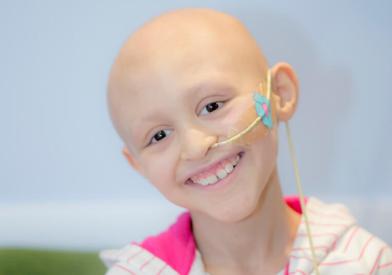What Is Wilms Tumor?
Wilms tumor, also called nephroblastoma, is a cancerous tumor in the cells of the kidney. With the right care, Wilms tumor is highly treatable.
- Wilms tumor is the most common type of kidney (renal) cancer in children. Approximately 6 percent of all childhood cancers are Wilms tumor.
- About 500 children in the United States are diagnosed with a Wilms tumor each year.
- Wilms tumor can occur between infancy and age 15. It is most common in children age five or younger. Adults rarely have Wilms tumor.
- The tumor can spread outside the kidney, most often to the abdominal lymph nodes and lungs.
- With prompt and aggressive treatment, doctors can successfully treat Wilms tumor in most children.
At Dana-Farber/Boston Children's Cancer and Blood Disorders Center, we provide expert care for children with kidney tumors through our Kidney Tumor Program. Our team of pediatric surgeons has extensive experience treating children with Wilms tumor, including bilateral tumors.
Causes and Symptoms of Childhood Wilms Tumor
Most cases of Wilms tumor occur with no family history of the disease or other known cause. In some cases, children are born with a genetic predisposition to develop Wilms tumor.
These children have rare genetic syndromes such as:
- Hemihypertrophy (one side of the body larger than the other).
- WAGR syndrome (Wilms, aniridia, genitourinary abnormalities).
- Denys-Drash syndrome (a syndrome of renal failure, hypertension, and genital abnormalities).
- Beckwith-Wiedemann syndrome (an "overgrowth" syndrome).
The most common symptom of Wilms tumor is the sudden appearance of a solid mass in the abdomen. Though each child may experience symptoms differently, other symptoms may include:
- Abdominal pain
- Abdominal swelling
- Blood in the urine
- Constipation
- Decreased appetite
- Fever
- High blood pressure
- Weakness or tiredness
Wilms tumor symptoms may resemble other more common conditions or medical problems. If you notice that your child is experiencing any of the above symptoms, call your child's doctor right away.
How We Diagnose and Classify Childhood Wilms Tumor
We conduct multiple diagnostic tests to identify the size, location, and type of tumor and confirm the diagnosis. These tests may include imaging studies, biopsy, and blood and urine tests.
An essential part of diagnosing Wilms tumor involves staging and classifying the disease. It helps your child's doctor determine treatment options and prognosis. Wilms tumor staging is the process of determining whether the cancer has spread and, if so, to what extent. Doctors typically categorize kidney tumors into five stages.
Wilms tumor is staged as follows according to guidelines from the Children's Oncology Group (COG), a national consortium of pediatric cancer centers:
- Stage I: The tumor is limited to the kidney, and surgery can completely remove it. About 20 percent of tumors are stage I.
- Stage II: The tumor extends beyond the kidney, but surgery can remove it entirely. Roughly 22 percent of tumors are stage II.
- Stage III: Doctors cannot altogether remove the tumor surgically, or it spills during surgery (tumor cells reach the blood or another organ during surgery), but the disease is limited to the abdomen. Approximately 32 percent of tumors are stage III.
- Stage IV: The disease has spread from the abdomen through the bloodstream and may travel to other parts of the body, most often the lung or liver. About 20 percent of cases are stage IV.
- Stage V: The tumor is in both kidneys (bilateral tumor) at the time of diagnosis. Around 6 percent of cases are stage V.
After completing all necessary tests, our experts meet to review and discuss the findings. Then we will meet with you and your family to talk over the results and the best treatment options for your child's individual needs.
How We Treat Childhood Wilms Tumor
Your child's physician will determine a specific course of treatment based on several factors, including:
- Your child's age, overall health, and medical history
- Type, location, and size of the tumor
- The extent of the disease (stage)
- Your child's tolerance for specific medications, procedures, or therapies
- How your child's doctors expect the disease to progress
- Genetic characteristics of the tumor
Your child's treatment may include:
- Surgery: The first step in Wilms tumor treatment is surgery to remove the tumor. After surgery, we usually recommend chemotherapy and, sometimes, radiation therapy. However, we can treat some cases of low-stage Wilms tumor with surgery alone. The types of surgical procedures we use include:
- Radical nephrectomy: This procedure removes the whole kidney, tissue around the kidney, ureter (the tube that drains urine from the kidney to the bladder), and adrenal gland (which sits on top of the kidney). Surgeons will perform this operation if the tumor has occurred in only one kidney.
- Partial nephrectomy or kidney-sparing surgery: If your child has bilateral Wilms tumor (tumor in both kidneys) or a known predisposition to kidney cancer, your child's physician may recommend this procedure. The surgeon will remove the tumor while leaving the maximum amount of healthy kidney tissue.
- Chemotherapy: If the tumor is very large, your child's doctor may recommend chemotherapy to try to shrink the tumor before surgery. We may also use chemotherapy after surgery.
- Radiation therapy: The need for radiation depends on the tumor stage (extent of spread of the tumor) and tumor type. We may use radiation therapy for tumors that have spread to the lymph nodes, abdomen, or lungs.
- Stem cell transplant: In rare cases, your doctor may recommend a stem cell transplant to treat the tumor. It allows your child's physician to give high-intensity chemotherapy in difficult-to-treat cases of Wilms tumor. Stem cell transplantation and the treatment needed to manage its effects are complex and involve some risk.
After treatment, your child will continue to receive medical care and support through our pediatric cancer survivorship programs. We provide a comprehensive follow-up medical evaluation each year and support services such as genetic counseling, patient and family education, and psychosocial assessment.




